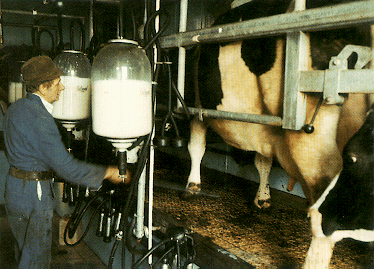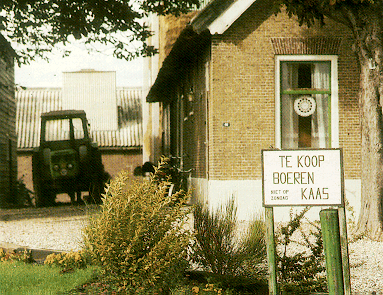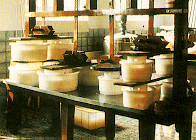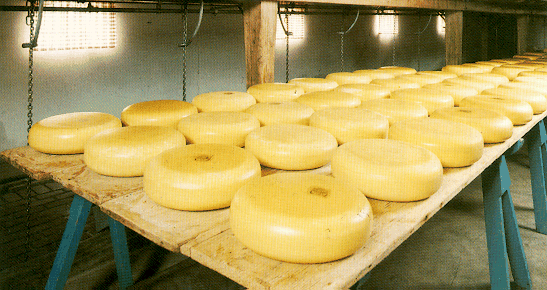 < Milking remains manual work even with the help of machines.
< Milking remains manual work even with the help of machines.

 < Milking remains manual work even with the help of machines.
< Milking remains manual work even with the help of machines.
In fact dairy products really begin their life even earlier, with the grass and the silage fed to the cattle. As well as milking twice a day, the farmer is busy all summer growing sufficient lush grass. The cattle graze the grass in the meadow, but some is cut and stored ready for winter feeding. Grass and silage provide the energy and basis of milk.
As well as the production of foodstuffs, feeding and milking, the farmer is
also kept busy improving his herd. During the six thousand years that the cow
has been kept by man, milk production has increased enormously. Nowadays it
averages 6000 liters per cow per year, some cows even produce 10.000 liters or
more per annum.

Cheese is still made on over 600 farms.
 Curds are pressed into shape in moulds >
Curds are pressed into shape in moulds >
Inside the farm there is a counter. The farmers wife is selling a wide variety
of cheeses to cheese lovers who come from far and wide to buy their particular
favourite. The farmer is busy with the vats in which the milk is left to
coagulate until it forms curds and one of their sons is busy turning the
cheeses in their plastic moulds. More cheese are ripening on the wooden
shelves which run along the walls.
You are always welcome to taste the cheese. From the mild flavour of young cheese, to the fulller flavour from cheese which have been left to mature for several months. If you close your eyes the taste of the various cheeses combined with the sweet smell of the farm brings the past to the present day.
Make an appointment
On many farms the farmer and his wife will be happy to show you how cheese is made. Contact the Dutch Dairy Bureau for a list of the farms open to visitors and where cheese is sold. In some cases the farms are only open to visitors during restricted periods and many only make cheese during the summer months. In any event - always make an appointment before you call.

Cheese maturing on unpainted wooden boards.
Sheep cheese or ewes'cheese is white like goat's cheese, but usually it has a milder flavour. In any event, not many sheep are kept for their milk in Holland as most are reared for their wool and meat.